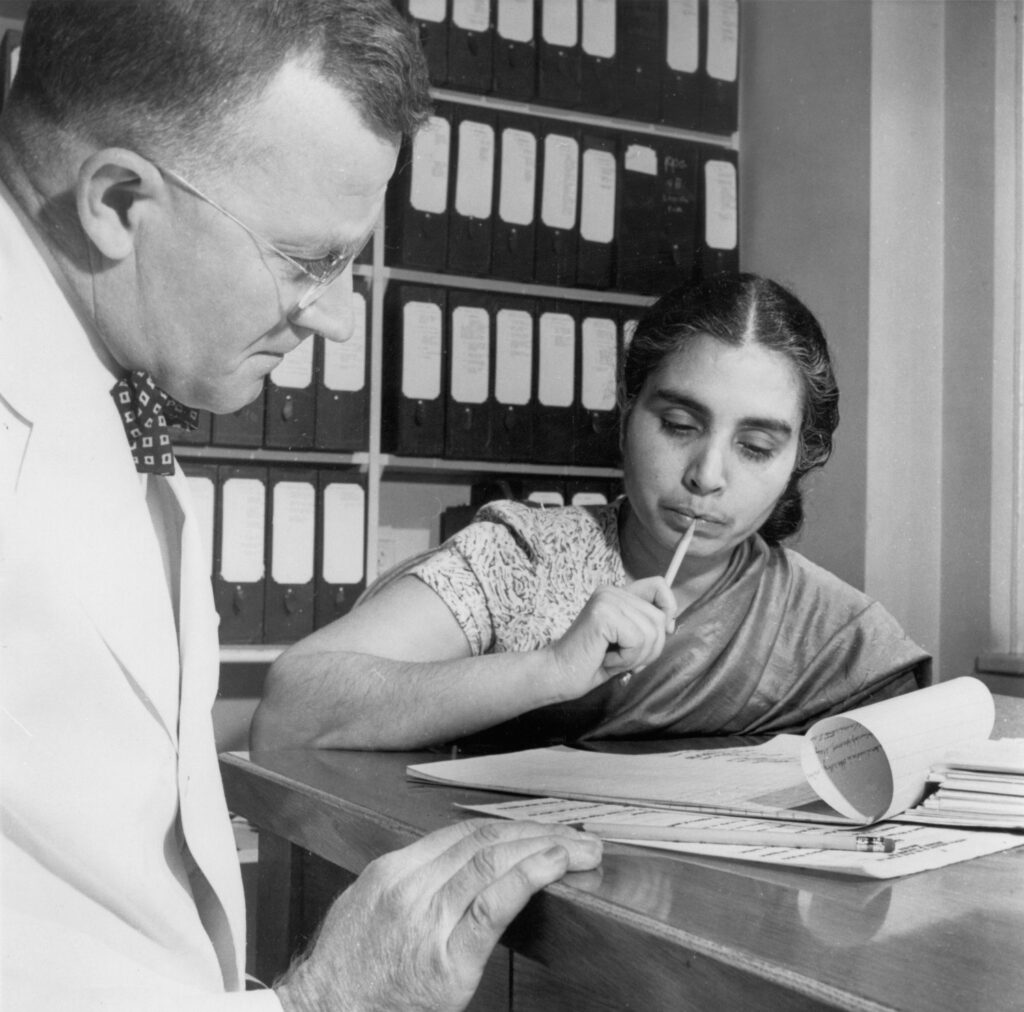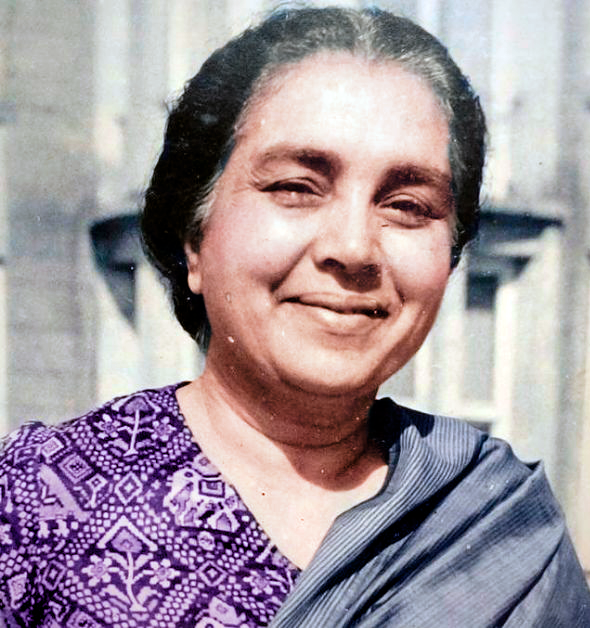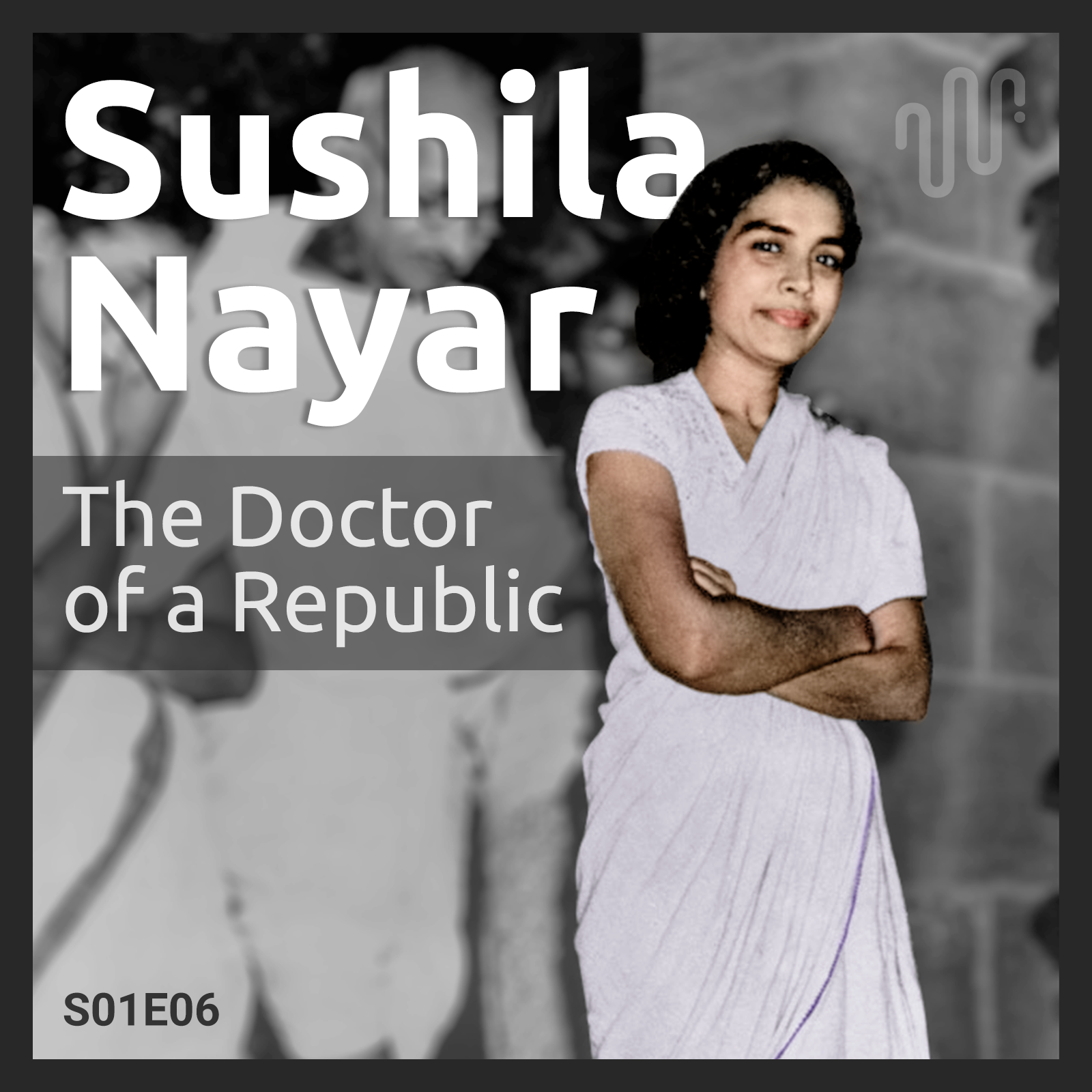Dr. Sushila Nayyar is perhaps best known for being the personal doctor to Mahatma Gandhi. She can be seen besides him, supporting him and helping him walk in a lot of photos. Her story however goes much further than these photos. She was a freedom fighter who played pivotal roles in the struggle against British. She went on to be the Union Minister of Health and set up the first rural medical college of Independent India. Her political career and public health advocacy played important roles in shaping the healthcare systems in a young and developing India.
The relatives were afraid to shelter the children of rebels
Sushila Nayyar – Understanding Gandhi: Gandhians in Conversation with Fred J Blum
Sushila Nayyar was born in 1914 in a small town in a middle-class family which was devoted to Gandhi. Sushila had two older brothers, oldest was Pyarelal Ji, who was serving as an aid to Gandhi. She met Gandhi the first time when she was just six years old when her mother took her along to meet him in Rohtak where he asked her to meet him later in Lahore instead. Sushila’s father had already passed away and her mother wanted to request Gandhi to let her son Pyarelal return home to take care of her family. During the meeting with Gandhi, her mother could not say what she had rehearsed and instead asked him to return Pyarelal after a few years. Noticing Sushila’s non-khadi clothes, Gandhi later asked her mother “Why don’t you give this little girl to me”, a request her mother denied. While Sushila was at a boarding school, her mother was often in prison for activities related to the Satyagrah movement. This brought her close to the Ashram where she used to spend her vacations. “The relatives were afraid to shelter the children of rebels.” She said in an interview with Fred J Blum.
Sushila studied Medicine at Lady Hardinge Medical College in Delhi, from where she earned her MBBS. She took a course of studies in maternal and child health in Kolkata. There she helped Gandhi while he was suffering from High Blood Pressure. On insistence of Dr. B. C. Roy, Gandhi’s doctor, she returned with and stayed with Gandhi for a month to monitor his health. In 1939, Gandhi travelled to Rajkot and took Sushila with him as his ‘Personal Physician’. She wrote in her book ‘Mahatma Gandhi’s Last Imprisonment’, “I was flattered but felt somewhat embarrassed by the title as I was just a raw graduate, very young and inexperienced. When Journalists approached me for the news about Gandhiji’s health, I could hardly talk with them”.
Gandhiji was not the man to keep a doctor for himself. So, I became the doctor for all the Ashram inmates and the villagers around Sevagram. I set up a dispensary in Sevagram, and learnt to train and use volunteers to fight epidemics and give medical care to villagers. In this way I was initiated into the concept of integrated, preventive and curative medical practice and community medicine which, as everyone today agrees, must form the basis of India’s health services.
Sushila Nayyar – Understanding Gandhi: Gandhians in Conversation with Fred J Blum
Sushila completed her exams for Doctorate of Medicine from the same college in 1942 and was awaiting results. She was planning to travel back to Sevagram but got a tip from her acquaintance working for the Viceroy’s office that there were going to be mass arrests in Bombay during an AICC meeting. Quoting her, “I had no notion at that time that I was going to plunge headlong into the Quit India Movement on reaching Bombay. I arrived in Bombay on August 8, as the train had to do a detour because of breaches on the railway line owing to heavy rains. The next day I found myself in Prison.”
On 8th August 1942, Mahatma Gandhi declared the ‘Quit India Movement’ at Gowalia Tank Maidan after a near unanimous vote at the AICC meeting. It was a clear demand that the British leave India in an orderly manner. Gandhi was arrested the following morning under the Defence of India Ordinance. Kasturba Gandhi was to deliver the first speech after this in Gandhi’s stead and it was expected that she would be arrested. Since Kasturba was not in good health, others asked Sushila to go with her to the meeting and expectedly, the prison, since she was a doctor. Kasturba Gandhi along with Sushila and her brother were arrested before the speech from Birla House, they were taken to Arthur Road Prison in Bombay. Before their arrest, a police officer pleaded Kasturba “Mother, you should stay at home; you are too old for such things”. After Kasturba didn’t reply, he turned to Sushila and said “You are too young, you should not go to this meeting”. Sushila felt he was mocking her. After they didn’t respond, he smiled and put them under arrest.
I was happy that at last I had an opportunity to participate in the struggle for India’s Independence and to go to prison as a Satyagrahi
Sushila Nayyar
On her first day in prison, Sushila did not eat anything despite being very hungry, she slept the whole day till next morning. The Jail Superintendent had informed her and Kasturba that they were not allowed any contact from the outside world. Quoting her “I was happy that at last I had an opportunity to participate in the struggle for India’s Independence and to go to prison as a Satyagrahi”. Soon after, they were transferred to Aga Khan Palace Detention Camp in Pune, the ‘Luxury Prison’ where Gandhi was being kept. The Detention Camp was considerably more comfortable compared to the Arthur Road Prison in Bombay. Sushila tried to get a word out about their whereabouts using a prescription but her plan was denied by Gandhi.
One day in August 1942, at Aga Khan Palace, Mahadev Desai, the personal secretary of Gandhi who was being kept in the same prison, passed away after a sudden heart attack. During following few months, Sushila took to reading books and reciting Bhagwad Gita and Ramayana to requisite strength and keep busy. She took over the work of compiling the memoirs of Bapu which was undertaken by Mahadev Desai. Her journal titled ‘Mahatma Gandhi’s Last Imprisonment’ describes her life during this period. A few months later, on 22 February 1944, Kasturba Gandhi also passed away. During this time her brother was also transferred to the same prison. Gandhi and his aids including Sushila and her brother were released on 5th May 1944. This was done because Gandhi was in poor health and had a severe case of Malaria, the British Government was concerned about the riots if he died in prison. In total, Sushila and her brother Pyarelal spent a total of 93 weeks, or almost 2 years in the prison.
This was during the times of pre-partition riots. During this she set up a small dispensary in the ashram for the villages around. Soon, this dispensary was converted into a clinic donated by G D Birla and soon after, it was turned into a full hospital named after Kasturba. We don’t know enough details about her story during this time, but we know that she was actively involved in the rehabilitation of people post partition. She was deployed by Gandhi in riot affected areas to serve as medical help and recruit volunteers to aid the injured or pregnant women. She was also deployed at Noakhali in 1946 in Bengal, tending to the sick and injured and post-partum women after the riots. She was often deployed alone, to work with the locals and source everything on her own.
In 1948, Sushila was sent to Pakistan, a dangerous journey back then, to find out if Hindus and Sikhs living there are being harassed or in danger. It was during this journey that in Multan she learned that Gandhi had been shot. She says “the Deputy Commissioner had invited us for a cup of tea. We were having tea in this house when a woman rushed in and said, ‘Look, what this world has come to, they say Gandhi has been shot.’ I was standing with a cup of tea in my hand. Naturally I was upset, so I sat down”. She made a night journey back to India and on the way her dread was confirmed by Nehru’s voice on the radio “The Light has gone out…”. She continued to serve the riot-affected areas for some time and in June of 1948, moved to United States to refresh her Medical knowledge.

She joined the Johns Hopkins University to receive a degree in Doctor of Public Health. She returned to India in 1950 after that. Upon her arrival she was appointed the Chief Medical Officer at Faridabad. Faridabad was a refugee township where she worked for over a year tending to the migrants and other villages surrounding the township. During this period, she set up a Tuberculosis Sanatorium and became the head of Gandhi Memorial Leprosy Foundation. Eventually, in 1952, she was convinced by her associates to stand for the elections in Delhi state. She became the first Minister of Health of Delhi. She was additionally given three more portfolios, Rehabilitation, Transport, Charitable Endowments of Delhi. After three years in 1955, she became the speaker in the Delhi State Vidhan Sabha.
I found working with Mrs Gandhi was not congenial. She had a strange way of working
Sushila Nayyar
In 1956 when Delhi ceased to be a state, she stood for and won the elections from Jhansi Constituency for Lok Sabha in 1957 and then again in 1962. She served as the Union Minister for Health, Local Self-Government, Country and Town Planning from 1962-64 in Nehru Cabinet. After Nehru’s death, she again served as the Union Minister for Health and Family Planning from 1964-67 in Lal Bahadhur Shastri’s cabinet. She also served as the president of National Society for Prevention of Blindness starting 1964 and All India Prohibition Council starting 1967. She again stood for elections in 1967 and won, however she did not enjoy working with Indira Gandhi. Quoting her “I found working with Mrs Gandhi was not congenial. She had a strange way of working”. In the 1969 Congress Split, she sided with the faction against Indira, post that in 1971 she contested lost the elections.
Even during this period, she kept herself focused on her mission of Rural Public Healthcare. She set up the Mahatma Gandhi Institute of Medical Sciences, the first rural medical college in India, in 1969. During the emergency she kept working with the masses against oppression. At a certain point she was started being harassed by police for her work. She recalls in her interviews with Fred J Blum, “On 2 October 1975, we had gone to Rajghat. The police surrounded us. They wanted me, and Acharya Kripalani to accompany them”. A request for which she replied “Without the warrant I will not accompany you”. Continuing, she narrates, “So we sat there for about four hours surrounded by the police. And then the higher-ups must have said, ‘No, don’t arrest them’. So, they didn’t arrest us”. When the Janta Party was formed, she joined and contested in elections in 1977. Quoting her “I fought the elections as a Janata Party member and won. I am now working in Parliament, working for my medical institution, working for prohibition, National Society for Prevention of Blindness, and I have been working since 1950 for the children of underprivileged people, particularly the untouchables and other slum dwellers”.
In 1995, Sushila suffered a heart attack, although heart conditions and osteoarthritis did not stop her from continuing her work. She dedicated her life to first the Independence of India, then Public Health, and in her last years, Public Education. She became the Chancellor of Gujarat Vidyapeeth and resolved the issues plaguing it from within. She passed away of a heart attack in 2001 at the age of 95. She never married or had a family of her own, public health was her only focus. It would not be disingenuous to say that her contributions as a freedom fighter, public healthcare official, and educator have shaped this country in its early years for the better. She wrote several books during her lifetime, most about Gandhi, the work she undertook from her brother and Mahadev Desai. She received a number of awards including the presidential award for her books and contributions to the public healthcare systems in India.

Her life sets and example on how sometimes our lives are beyond our control, either for a cause greater than us or because others want us to do something for them. She proved however that it is possible to rise even beyond one’s duties. Despite being involved in most politically charged periods of Indian history, she stuck with the truth. Through her life, she was faced with multiple choices. These choices often boiled down to the truth vs what was easy, and without fail, she chose the Truth. From not avoiding Jail and undertaking her duties to standing up to the Mahatma himself when it was needed. She chose to not give in to people who considered her ‘just a little girl’. People speculated about her relationship with Bapu but she didn’t pay attention to them. She even stood against the forces of one of the biggest oppressive regimes in the world. When the world was asking her to sit down, or move out of the way, she planted herself like a tree, looked the world in the eye and said ‘No, you move’.
Sources:
- https://www.mgims.ac.in/index.php/sushila-Nayyar-birth-centenary
- http://archive.nmji.in/archives/Volume-14/issue-2/obituary.pdf
- https://archive.org/details/Hind.Gandhi.Last.Imprisonment/page/n29/mode/2up
- https://retrospective.jhu.edu/our-collection/paul-harper-with-sushila-Nayyar
- Understanding Gandhi: Gandhians in Conversation with Fred J Blum by Usha Thakkar and Jayshree Mehta [2011] ISBN 9788132105572.
